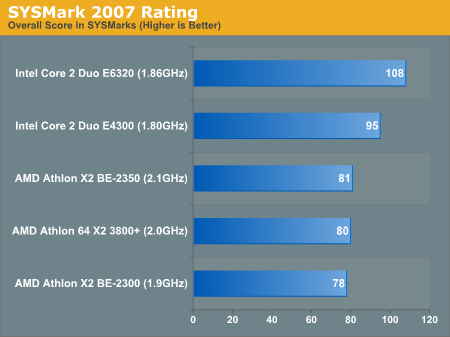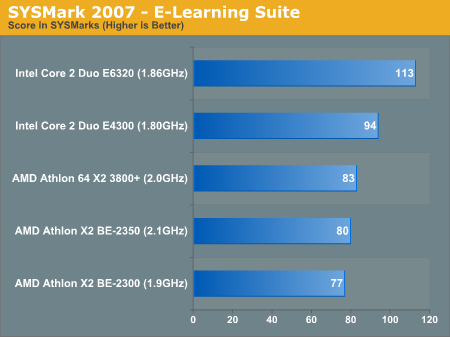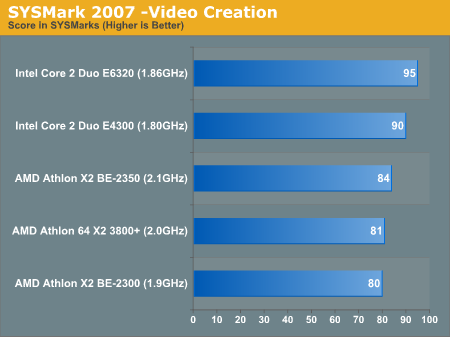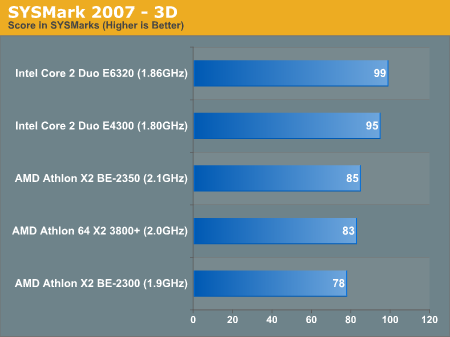AMD Athlon X2 BE-2350: Mainstream X2s with 45W TDP
by Anand Lal Shimpi on June 5, 2007 4:09 PM EST- Posted in
- CPUs
General Performance
After years of waiting we can finally move away from SYSMark 2004 as BAPCo has just released SYSMark 2007, its latest benchmark suite that boasts full Vista compatibility (only 32-bit however). As always, SYSMark is divided into a number of individual performance categories, which together provide an overall performance score for the system.















46 Comments
View All Comments
reload1992 - Wednesday, February 27, 2008 - link
I am building my first pc. Is this a good cpu for gamingNil Einne - Monday, June 11, 2007 - link
The reviewer correctly pointed out at the beginning that AMD has remained competitive by aggresively pricing their processors. Then at the end, they correctly pointed out that for non-overclockers, the BE-2350 isn't a bad choice. But the reviewer then somewhat stupidly suggested that people wanting a quite office system should just go with the E4300 because it offers better performance. This misses several points. Firstly if you just have an office system, you're probably rarely using the extra performance so it's questionable whether it's worth it. Secondly, the reviewer didn't consider mobo price. From what I've seen equivalently speced AMD mobos tend to be a bit cheaper then Intel ones.More importantly perhaps, the reviwer didn't consider other Intel or AMD offerings. There are the Pentium Es as others have mentioned. But there are also the older AMD chips. The X2 4200+ EE for example if you're looking for a low power chipped. And if you're not quite so worried about power, the X2 4600+ is about the same price as the E4300 but generally performs better. For a typical office system, the processor will mostly be in CnQ mode anyway so the actual power consumption probably won't change much.
So unfortunately, it appears the reviewer, despite agreeing at first that AMD is competitive, has then completely missed the point of why AMD is competitive. AMD may be clock for clock slower, but they've priced their processors aggresively enough that they remain competitive for non overclockers from a price/performance standpoint. This trap is something a lot of reviwers seem to fall in sadly. Rather then saying stupid things like well the Intel system is faster and only a 'little bit' more (even when you don't need the extra performance) so you should go Intel, what they should be acknowledging is that price/performance wise they're fairly competitive because you can (at the low to medium end) get a better performing AMD system for a 'little bit' more too. If editors aren't going to consider the details, they should just refrain from making frankly silly comments in the conclusion.
psychobriggsy - Wednesday, June 6, 2007 - link
AMD will be positioning these chips to be used with the AMD690G chipset.The Tech Report found that the nVidia SLI chipset used 14W more than the 690G (when used with an external graphics card).
Comparing SLI with the Intel P965 is rather disingenous, and makes the power consumption page worthless, and quite misleading. Why didn't you use nVidia's Intel SLI chipset to make things more even? Or at least have a test with a motherboard using AMD's chipsets?
cocoviper - Thursday, June 7, 2007 - link
I agree wholeheartedly.Anand could we get an update to the article testing equivalent chipsets? (Either an integrated graphics chipset on the AMD side vs. the 965; or retest the Intel power consumption numbers with an Nvidia SLI chipset?)
Otherwise we might as well just toss out that entire power consumption page, because as it is right now the power delta between different mobo chipsets is as much or more than the power delta between the processors on that graph.
strikeback03 - Friday, June 8, 2007 - link
First paragraph, last page.
Nil Einne - Monday, June 11, 2007 - link
I think you're missing the point tho. It was a bit silly to include the power graph in the first place since it's meaningless. Some reviewers seem to like to include graphs and data which is pointless at best and at worst misleading. This isn't exclusive to this instance or to Anandtech. There are a lot of stupid stuff out there (other examples include benching medium end cards at 1600x1200 with 4xAA and 8x Aniso). Other then wasting a readers time, the trouble here is that a lot of people don't properly read reviews, just skip through them and look at the graphs briefly. They see the graph and conclude the Intel has a lower power usage. They don't notice that the reviewer was bizarrely enough, comparing a SLI mobo with an integrated one so the graph is somewhat useless.yacoub - Wednesday, June 6, 2007 - link
My E4400 runs at 3.0GHz w/o breaking a sweat. $135 CPU that clocks to a $300 CPU's speed. I haven't been able to buy a CPU that cheaply literally in a decade. Last one that offered such a high ROI with a simple 50% overclock was the Celeron 300A (300MHz, ran at 450MHz).myterrybear - Tuesday, June 5, 2007 - link
I think I am mentioning something that was greatly missing from this review .. the results of the cpu on a AMD690G based motherboard. There should be a big diffrence especialy on the thermal ussage test IF a AMD690G based board was used insted of a nvidia based one.duploxxx - Wednesday, June 6, 2007 - link
fully agree on that.it is again a wrong comparisson. you put on of the most expensive en powerhog board to measure the performance of a low tdp cpu and put it against a mainstream competitor board.
you can lower each powermeasurement by approx 20-25W for all the k8 series in this test.
not even to mention the big price difference if you also use a mainstream board from AMD.
Strange that Intel won't provide you some new e2xxx series. might already tell enough about the price/performance ratio.
fromm older articles we alreaady know that a e4300 must be compared with the x2 4600 and a e6300 with 5000-5200. they already have the same price and in amd's favor if you add the motherboard to the combo.
MRM - Thursday, June 7, 2007 - link
Maybe the tester here should look at this testhttp://techreport.com/reviews/2007q2/athlon-x2-be2...">http://techreport.com/reviews/2007q2/athlon-x2-be2...
Here you can see the difference. Put the AMD on a nVidia board, and it will consume more power then the intel, but put the AMD on a 690g board, then the AMD will save more energy.
So my conclusion is, if you want performance, go with Intel. But if you want a low power system ( maybe for Office, Internet or as HTPC ) then AMD is better, because it consume less power - but only if you pick the right chipset.